
9 minute read
Traumatic Brain Injury's Effect on Vision
MICHAEL COLE, OD Child and Family Eye Care Center
Traumatic brain injury (TBI) can have a profound effect on those unfortunate enough to experience it. Many systems in the body are thrown into disarray and often it becomes a long road to recovery before one starts to feel comfortable again. In our clinic, we have treated vision concerns for a wide variety of injuries ranging from concussions in sports, car accidents, strokes, military service, gunshot wounds, and even a lightning bolt to the head! There unfortunately seems to be a neverending list of possibilities for a brain injury, and thankfully we have been able to aid in recovery for these patients.
Advertisement
In all, close to 70% of post-TBI patients have vision diagnoses. This does not, however, mean that these patients see an increase in blurry vision or need a new glasses prescription. Rather, these patients struggle with other aspects of vision that may go untreated if they are not evaluated properly. Routine eye examinations that evaluate eye health and visual acuity alone will not be adequate to identify these problems when they exist.
The most common visual complaints are accommodative disorders. Accommodation refers to the ability of our eyes to change focal distances. Much like a camera lens, our eyes can change focus to view objects at different distances. Post-TBI patients often find themselves unable to read or otherwise see clearly up close like they were able to prior to sustaining the injury. This ability can be restored with time and training, and sometimes requires the use of additional corrective lenses to aid in the short term before recovery can commence.
Around half of patients experience convergence insufficiency, or the inability to adequately aim both eyes at a near target. Without a strong convergence system, it is difficult to perform near tasks without double vision. Often patients will complain of tired, achy eyes and frequent headaches. Many are unable to continue hobbies such as reading or sewing due to the excessive strain and poor vision. It is our pleasure to aid in the return to such activities and a normal life for these individuals.
Sometimes eye movements are affected after brain injuries. Depending on the area of the brain that is hurt, different types of eye movements can be impaired. Some patients have damage to the saccadic control areas which plan high-speed positional changes of the eyes to new locations. This is the type of motor movement used when reading or changing gaze to look at a new target of interest. Different areas of the frontal lobe plan smooth movements, called pursuits that allow us to follow a moving object without losing our aim. It can be very frustrating for patients unable to initiate or accurately carry out these basic functions of vision. Fortunately, this too can be improved with rehabilitation.
In cases of severe injury to specific areas of brain tissues, sometimes different areas of our visual field are lost. For example, an injury to the occipital lobe can cause a complete loss of vision on one side of our vision. This would mean that one could see clearly straight ahead and to one side of peripheral vision. The other side of the periphery, however, could be completely lost. Patients such as these often need vision aids and training to help them navigate the world due to the now unseen portions of their vision.
Unfortunately, all too often these patients struggle with these vision concerns without treatment. If you or a loved one is in need of help in this area, please schedule a consult with our clinic.

Cache Valley Civic Ballet Celebrates 40 Years of Nutcracker Magic
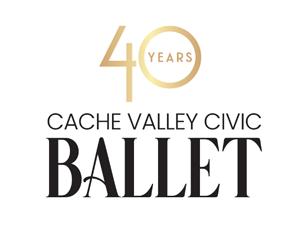
EMILY BUCKLEY editor in chief
When Sandra Emile, founder and artistic director of the Cache Valley Civic Ballet, arrived in Cache Valley in 1981 for her husband’s employment at Utah State University, she never dreamed this is where she’d stay and build a career, but she had an instinct to bloom where she was planted and decided, when given the opportunity to take on a small, grant-funded ballet chorography project, to put her American Ballet Theatre training to work. In exchange for directing Peter and the Wolf, she would be given the opportunity to take up space rent-free in the historic Whittier Community Center for a couple of months to see if she could attract ballet students.
After that first successful production of Peter and the Wolf on the small Whittier Community Center stage, Sandy committed herself to producing The Nutcracker, and so began the Cache Valley Civic Ballet.
Now, 40 years later, the Cache Valley Civic Ballet is preparing to put on their 40thanniversary production of The Nutcracker with a cast of more than 75 and the live accompaniment of the 43-piece Northern Utah Symphony Orchestra. “I never thought I would see this organization grow to the size it is or touch as many lives as it has,” Sandy said. “It has really been a privilege. I look back at what we have done and what our dancers have accomplished with pride and satisfaction, and then turn and look forward with anticipation for what we can achieve in the future.”
Pyotr Ilyich Tchaikovsky's ballet The Nutcracker has become the most frequently performed of all ballets in the world, according to National Public Radio (NPR). It has served as an introduction to classical music for many young people and is a ballet that even non-ballet goers make a holiday tradition, beloved by children and adults alike.
It is a magical tale of the little girl, Clara, who is given a nutcracker as a Christmas gift and then dreams that it comes to life and goes into battle with toy soldiers and mice. Her Nutcracker Prince then escorts her to the Land of the Sweets, where they meet the Sugar Plum Fairy who calls on her court to entertain the pair with a dazzling, colorful display of dances, culminating in a beautiful performance by the Sugar Plum Fairy and her Prince.
The Nutcracker was first performed in Russia in 1892, and was not terribly successful at the time. The first complete performance outside of Russia was not until 1934 in London.
Brigham City native and dance pioneer Willam Christensen brought The Nutcracker to the United States. He was a Vaudeville star before establishing the San Francisco Ballet in 1941. ‘Mr. C.’, as he came to be known, staged America’s first full-length production of the now-beloved ballet on Christmas Eve 1944 in San Francisco. This historical production
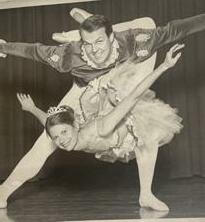
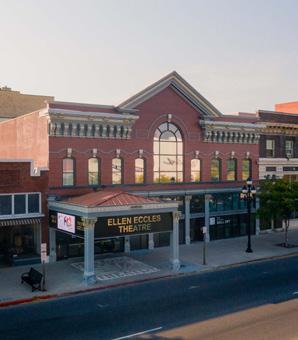
Ellen Eccles Theatre to Mark 100th Anniversary
Courtesy of Cache Valley Center for the Arts
In 1912, when the Thatcher Opera House was destroyed by fire, George and Brigham Thatcher envisioned an ornate, first-class theatre to replace it. This vision became reality when the new Capitol Theatre opened on March 29, 1923. At the hefty price of $250,000, the beautiful new theatre boasted a fly system, excellent acoustics, and an opulent interior. Named for its rival in Salt Lake City, the Capitol Theatre contributed to the image of Logan as “the Athens of Utah” and for the next few decades it was at the heart of cultural activities in Cache Valley.
The beautiful structure was grand enough to attract the great entertainers like Abbot and Costello, John Philip Sousa, the Marx Brothers, George Burns, and Gracie Allen. Live performances shared the stage with films, dominant through the 1930s. As television emerged in the 1950s the crowds waned and films shared the space with community productions.
By the 1980s, the Capitol Theatre had suffered from years of neglect. The ornate plasterwork had been painted industrial green, burlap sacks covered the stunning murals portraying the mythical phoenix bird, and a massive plywood wall blocked the stage. Some spoke of demolishing the building to provide additional parking. A few visionary citizens led by Michael Ballam, seeing a greater potential, united the community in an ambitious $6.5 million project to restore the theatre and create the adjacent Bullen Center. As a result of this grassroots effort, the building was transferred to the City of Logan, becoming a community theatre in the very best sense. Thousands of volunteer hours were contributed to the effort, and on January 8,1993, the Capitol Theatre was reopened and renamed Ellen Eccles Theatre in honor of early Logan resident and philanthropist Ellen Stoddard Eccles.
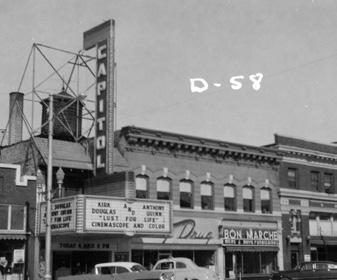
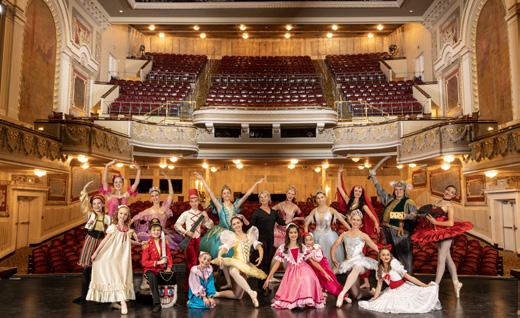
Ellen Eccles Theatre
99
YEARS SINCE OPENING IN JANUARY 1923
100+
PERFORMANCES AT THE ELLEN ECCLES THEATRE EACH YEAR
7,000+
HOURS OF VOLUNTEER USHER SERVICE EACH YEAR
sparked a long-lasting cultural phenomenon that continues on stages around world today. Mr. C. eventually returned to Utah and founded the ballet department at the University of Utah in 1951 and Ballet West in 1963.
According to Willam Christensen’s obituary in 2001, someone once asked him how long he thought The Nutcracker would continue. He said, "I suppose it will go as long as there are children being born and as long as there's a Santa Claus."
The Nutcracker tradition is one that is full of magic, and that is also why Sandy believes audiences return year after year, and why she has enjoyed directing the production for four decades straight.
“I don’t think we ever outgrow the desire for Christmas magic, and wishing for a place to have all your dreams come true,” she said. “Creating that as a dancer or as a director, and being part of telling that story for others to enjoy, even if only for a little while, well, that’s magic and who wouldn’t want to be part of that? It’s like putting up the Christmas tree, every year, it’s the best tree ever, even when we know we said the same thing last year and the year before that.” part of The Nutcracker is, is like asking a mother who her favorite child is, only she has an answer: “I love it all, but the best part is the start of snow, at the end of the first act,” she said. “I set the dancing to be part of the music, which mimics the way a gentle winter snowfall starts. Quietly, a few flakes at a time until the music grows, and the stage is full of flakes dancing through the air. I have always loved a good snowfall.”
For those who have never been to the ballet, Sandy says they shouldn’t overthink it. “It’s just the telling a story or sharing an emotion with the audience without using any words. Relax and enjoy it.”
Sandy is honored to have such a beautiful venue for her dancers to perform in. “We are lucky,” she said. “There are few communities of our size in our type of location that have such a lovely ‘jewel box’ to perform in. I truly appreciate the community support of this lovely theater and the incredible staff that operates the facility.”
The Cache Valley Civic Ballet performance of The Nutcracker will be performed at the Ellen Eccles Theatre Thanksgiving weekend. Tickets are available at cvcballet.org.












